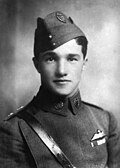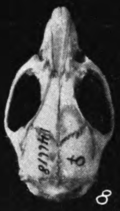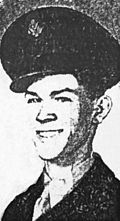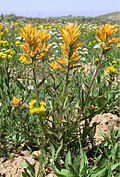Wikipedia:Today's featured article/May 2014
| << | Today's featured articles for May 2014 | >> | ||||
|---|---|---|---|---|---|---|
| Su | Mo | Tu | We | Th | Fr | Sa |
| 1 | 2 | 3 | ||||
| 4 | 5 | 6 | 7 | 8 | 9 | 10 |
| 11 | 12 | 13 | 14 | 15 | 16 | 17 |
| 18 | 19 | 20 | 21 | 22 | 23 | 24 |
| 25 | 26 | 27 | 28 | 29 | 30 | 31 |
May 1
Ipswich Town Football Club are an English professional football team based in Ipswich, Suffolk. As of the 2013–14 season, they play in the Football League Championship, having last appeared in the Premier League in 2001–02, making them the Championship's longest-serving club. The club was founded in 1878 but did not turn professional until 1936, joining the Football League in 1938. They play their home games at Portman Road in Ipswich. The only fully professional football club in Suffolk, they have a long-standing and fierce rivalry with Norwich City in Norfolk, with whom they have contested the East Anglian derby 138 times since 1902. Ipswich won the English league title in 1961–62, and have twice finished runners-up. They won the FA Cup in 1977–78, and the UEFA Cup in 1980–81. They have competed in the top two tiers of English football uninterrupted since 1957–58, currently the longest streak among Championship clubs. They have competed in all three European club competitions, and have never lost at home in European competition. Former managers include Alf Ramsey (statue at Portman Road pictured) and Bobby Robson, both of whom later managed the England national team. (Full article...)
Recently featured: Iranian Embassy siege – HMS Endeavour – U.S. Route 40 Alternate (Keysers Ridge–Cumberland, Maryland)
May 2
Lochry's Defeat was a battle fought on August 24, 1781, near present-day Aurora, Indiana, in the United States. The battle was part of the American Revolutionary War (1775–83), in which American Indians were allies of the British. The battle was short and decisive: about one hundred Indians under Joseph Brant (pictured), a Mohawk war leader, ambushed about an equal number of Pennsylvania militiamen led by Archibald Lochry, and killed or captured them all without suffering any casualties. Lochry's force was part of an army being raised by George Rogers Clark for a campaign against Detroit, the British regional headquarters. In early August 1781, Clark and about 400 men left Fort Pitt in Pennsylvania by boat on the Ohio River, a few days ahead of Lochry and his men. Brant's force was part of a combined British and Indian army being raised to counter Clark's offensive. Brant had too few men to challenge Clark, but he intercepted messengers between Clark and Lochry and learned about Lochry's smaller group. When Lochry landed to feed his men and horses, Brant launched his overwhelming ambush. The loss of Lochry's men resulted in the cancellation of Clark's expedition. (Full article...)
Recently featured: Ipswich Town F.C. – Iranian Embassy siege – HMS Endeavour
May 3
"What Is and What Should Never Be" is the twentieth episode of the paranormal drama television series Supernatural's second season, and was first broadcast on May 3, 2007. Dean Winchester (Jensen Ackles) finds himself in an alternate reality after a confrontation with a djinn. The creature appears to have fulfilled Dean's greatest wish: that his mother had not been killed when he was a child. Dean is happy until it becomes apparent that his previous work as a hunter of supernatural creatures has been undone. He then rejects the alternate reality and attempts to bring himself back. The episode was written by Raelle Tucker, and marked the directorial debut of series creator Eric Kripke. It featured the return of deceased characters Mary Winchester (Samantha Smith) and Jessica Moore (Adrianne Palicki, pictured). Kripke enjoyed expanding upon the character of Mary, who was only briefly depicted in earlier episodes. Despite obtaining low ratings, the episode acquired positive critical reviews, praising Ackles' performance and welcoming the return of Smith and Palicki. Tucker also received a Constellation Award for her work on the episode. (Full article...)
Recently featured: Lochry's Defeat – Ipswich Town F.C. – Iranian Embassy siege
May 4
Art Houtteman (1927–2003) was an American right-handed pitcher in Major League Baseball. In 325 career games, Houtteman pitched 1,555 innings and posted a win–loss record of 87–91, with 78 complete games, 14 shutouts, and a 4.14 earned run average. He was signed by scout Wish Egan in 1945 at 17 years of age, and joined a Detroit Tigers pitching staff that had lost players to injuries and World War II. After moving between the major and minor leagues over the next few years, he was nearly killed in a driving accident just before the 1949 season. Houtteman rebounded from his injuries and went on to win 15 games that season and made his only All-Star appearance in the following year. He played three more seasons with the Tigers, then pitched for the pennant-winning Cleveland Indians during their 1954 season. After losing his position as starting pitcher, he played two more seasons with the Indians before he was bought by the Baltimore Orioles, with whom he finished his final season in Major League Baseball. Houtteman ended his baseball career in the minor leagues and became a sales executive in Detroit. (Full article...)
Recently featured: "What Is and What Should Never Be" (Supernatural) – Lochry's Defeat – Ipswich Town F.C.
May 5
Roekiah (1917–1945) was a kroncong singer and film actress from the Dutch East Indies. Born to two actors, she began her career at the age of seven, and by 1932 had become well-known in Batavia. Around this time she met her husband Kartolo. The two acted in the 1937 hit Terang Boelan, with Roekiah starring alongside Rd Mochtar; after the film's commercial success, Roekiah, Kartolo, and most of the cast and crew of Terang Boelan were signed to Tan's Film. They appeared in three films for the company, beginning with Fatima in 1938, before Mochtar left in 1940; his departure ended a partnership which had spawned numerous imitators. Mochtar's replacement, Djoemala, acted with Roekiah in four films, beginning with Sorga Ka Toedjoe, although these were less successful. During the peak of her career, Roekiah was a fashion and beauty icon, featuring in advertisements and drawing comparisons to Dorothy Lamour and Janet Gaynor. After the Japanese invaded the Indies in 1942, Roekiah took only one more film role before her death. Of her five children with Kartolo, one – Rachmat Kartolo – entered acting. Roekiah has often been cited as one of Indonesia's film pioneers. (Full article...)
Recently featured: Art Houtteman – "What Is and What Should Never Be" (Supernatural) – Lochry's Defeat
May 6
Castlevania: Aria of Sorrow is a 2003 side scrolling and platforming video game developed and published by Konami for the Game Boy Advance. In the game, it is the year 2035 and Dracula has been sealed in his castle since being defeated in 1999. Soma Cruz, a teenager with occult power, has been told that Dracula's reincarnation will acquire his powers, and Cruz battles dark figures in the castle who also wish to inherit these powers. The game incorporates the combination of elements from platform games and role-playing video games that were initially utilized in an earlier Castlevania game Symphony of the Night. Aria of Sorrow introduces several new features to the series, such as the "Tactical Soul" system and a futuristic storyline, a contrast to the medieval setting of many other Castlevania games. The game sold poorly in Japan but was commercially successful in the United States. It was praised by several video game publications, with many considering it one of the best games in the series since Symphony of the Night. A sequel was released in Japan in 2005. (Full article...)
Recently featured: Roekiah – Art Houtteman – "What Is and What Should Never Be" (Supernatural)
May 7
Albert Ball (1896–1917) was a British fighter pilot during the First World War. At the time of his death he was, with 44 victories, the United Kingdom's leading flying ace. Raised in Nottingham, Ball was commissioned as a second lieutenant in October 1914. He transferred to the Royal Flying Corps (RFC) the following year, and gained his pilot's wings in January 1916. He then joined No. 13 Squadron RFC in France, flying reconnaissance missions before being posted in May to No. 11 Squadron, a fighter unit. From then until his return to England on leave in October, he accrued many aerial victories, earning two Distinguished Service Orders and the Military Cross. He was the first British ace to become a popular hero. After a period on home establishment, Ball was posted to No. 56 Squadron, which was sent to the Western Front in April 1917. He crashed to his death in a field in France on 7 May, sparking a wave of national mourning and posthumous recognition, which included the award of the Victoria Cross for his actions during his final tour of duty. His most renowned enemy, Manfred von Richthofen, remarked upon hearing of Ball's death that he was "by far the best English flying man". (Full article...)
Recently featured: Castlevania: Aria of Sorrow – Roekiah – Art Houtteman
May 8
The Doom Bar is a sandbar at the mouth of the estuary of the River Camel on the north coast of Cornwall, England. It is composed mainly of marine sand, more than 60 per cent of which is derived from marine shells making it an important source of agricultural lime which has been collected for hundreds of years. According to tradition, the Doom Bar formed in the reign of Henry VIII, damaging the prosperity of the port of Padstow a mile up the estuary. Until the 20th century, access to Padstow's harbour was via a narrow and difficult channel between the Doom Bar and the cliffs at Stepper Point, and many ships were wrecked on the Doom Bar, including the 12-gun schooner HMS Whiting in 1816. In the early 20th century the main channel moved away from the cliffs, and continued dredging has made it much safer for boats, but deaths have occurred on the bar as recently as 1997. A Cornish folklore legend relates that a mermaid created the bar as a dying curse on the harbour after she was shot by a local man. The Doom Bar has been used in poetry to symbolise feelings of melancholy, and it has given its name to the flagship ale from Sharp's Brewery. (Full article...)
Recently featured: Albert Ball – Castlevania: Aria of Sorrow – Roekiah
May 9
In mathematics and theoretical physics, mirror symmetry is a relationship between geometric objects called Calabi–Yau manifolds (pictured). The term refers to a situation where two Calabi–Yau manifolds look very different geometrically but are nevertheless equivalent when employed as extra dimensions of string theory. Mirror symmetry was originally discovered by physicists. Mathematicians became interested in this relationship around 1990 when Philip Candelas, Xenia de la Ossa, Paul Green, and Linda Parks showed that it could be used as a tool in a branch of mathematics called enumerative geometry. Today mirror symmetry is a major research topic in pure mathematics, and mathematicians are working to develop a mathematical understanding of the relationship based on physicists' intuition. Mirror symmetry is also a fundamental tool for doing calculations in string theory, and it has been used to understand aspects of quantum field theory, the formalism that physicists use to describe elementary particles. Major approaches to mirror symmetry include the homological mirror symmetry program of Maxim Kontsevich and the SYZ conjecture of Andrew Strominger, Shing-Tung Yau, and Eric Zaslow. (Full article...)
Recently featured: Doom Bar – Albert Ball – Castlevania: Aria of Sorrow
May 10
The voyage of the James Caird was a small-boat journey undertaken by Sir Ernest Shackleton and five companions from Elephant Island in the South Shetland Islands to South Georgia in the southern Atlantic Ocean, a distance of 800 nautical miles (1,500 km; 920 mi). In October 1915, Endurance, the ship of the Imperial Trans-Antarctic Expedition of 1914–17, had been crushed by pack ice and sunk in the Weddell Sea, leaving the 27-man expedition stranded thousands of miles from safety. In April 1916, when the floe on which they were camped broke up, the party made its way in the ship's three lifeboats to the uninhabited Elephant Island. Shackleton decided that the best chance for rescue would be for a crew of six to sail a lifeboat to South Georgia; the James Caird was deemed the most likely of the lifeboats to survive the journey. After overcoming a series of dangers, including a near capsizing, the boat reached South Georgia after 16 days. Shackleton was then able to organise the relief of the Elephant Island party, and to return his men home without loss of life. The James Caird's voyage is regarded as one of the greatest small-boat journeys ever accomplished. (Full article...)
Recently featured: Mirror symmetry (string theory) – Doom Bar – Albert Ball
May 11
Oryzomys peninsulae, also known as the Lower California rice rat, is a species of rodent from western Mexico. Restricted to the southern tip of the Baja California peninsula, it is a member of the genus Oryzomys of family Cricetidae. Twenty-one specimens of O. peninsulae are known, caught in 1896 and 1906 at two locations about 13 km (8 mi) apart along the Río San José, a river in southernmost Baja California Sur. Río San José no longer exists, having fallen prey to irrigation projects, and touristic development of its estuary has resulted in pollution. Biologists working in the area in 1979 and from 1991 to 1993 failed to find O. peninsulae, casting doubt on its continued existence. Medium in size for its genus, it was first described as a separate species, but later lumped into other widespread species until it was reinstated as separate in 2009. It is distinctive in fur color—grayish brown on the forequarters and reddish brown on the hindquarters—and in some dimensions of its skull (pictured), with a high braincase, robust zygomatic arches (cheekbones), and long incisive foramina (perforations of the palate between the incisors and the molars). (Full article...)
Recently featured: Voyage of the James Caird – Mirror symmetry (string theory) – Doom Bar
May 12
Sigi Schmid (born 1953) is a German-American soccer coach. Born in Tübingen, West Germany, he moved to the United States with his family when he was a child. He played college soccer as a midfielder from 1972 to 1975 at the University of California, Los Angeles (UCLA). He coached his former college team between 1980 and 1999 and became one of the most successful collegiate coaches of all time. The UCLA Bruins made 16 consecutive playoff appearances from 1983 to 1998, winning the national championship in 1985, 1990, and 1997. Schmid also worked with US Soccer throughout the 1990s. Schmid has coached the Los Angeles Galaxy and the Columbus Crew in Major League Soccer (MLS). He became the head coach of Seattle Sounders FC in 2009. Throughout his career, Schmid has received praise from critics for his ability to identify new talent. His defensive tactics are also highly regarded in the press, although their deployment in his final two seasons with Los Angeles led directly to the termination of his contract. Despite never having played soccer at a professional level, he has the most coaching wins in MLS history, and was the recipient of the MLS Coach of the Year Award in 1999 and 2008. (Full article...)
Recently featured: Oryzomys peninsulae – Voyage of the James Caird – Mirror symmetry (string theory)
May 13
Millennium Force is a steel roller coaster at Cedar Point amusement park in Sandusky, Ohio, United States. Completed in 2000, it has broken and helped to break ten world records. It was also the first Giga Coaster (any complete circuit roller coaster that exceeds 300 feet (91 m) in height) in the world. It was briefly the tallest and fastest complete circuit roller coaster in the world, before being surpassed by Steel Dragon 2000 in August 2000. The ride is also the second-longest roller coaster in North America after The Beast at Kings Island, and was the first roller coaster to use a cable lift system, rather than a traditional chain lift. The coaster has a 310 ft (94 m), 45 degree inclined lift hill with a 300 ft (91 m) drop, and features two tunnels, three overbanked turns, and four hills. It has a top speed of about 93 mph (150 km/h). Since 2001, Millennium Force has been voted the number one steel roller coaster in the world eight times in Amusement Today's Golden Ticket Awards, and has never been ranked lower than number two. Although it is no longer the tallest or fastest roller coaster at Cedar Point, it is still one of the tallest and fastest in the world. (Full article...)
Recently featured: Sigi Schmid – Oryzomys peninsulae – Voyage of the James Caird
May 14
Australian Hospital Ship Centaur was attacked and sunk by a Japanese submarine off North Stradbroke Island, Queensland, Australia, on 14 May 1943, killing the majority of those on board. She had been launched in 1924 as a combination passenger liner/freighter, operating between Western Australia and Singapore. Following her early-1943 conversion to a hospital ship, Centaur served as a medical transport between New Guinea and Australia. Before dawn on 14 May 1943, while on her second voyage, Centaur was torpedoed. Of the 332 medical personnel and civilian crew aboard, 268 died, including 11 of the 12 nurses. The 64 survivors were discovered 36 hours later. The incident resulted in public outrage, as attacking a hospital ship was considered a war crime under the 1907 Hague Convention. In the 1970s the identity of the attacking submarine, I-177, became public. The reason for the attack is unknown, although there are claims that the ship may have been in breach of the international conventions that should have protected her. The wreck was found in 2009, although the incorrect identification of another wreck as Centaur stood from 1995 to 2003. (Full article...)
Recently featured: Millennium Force – Sigi Schmid – Oryzomys peninsulae
May 15
Mycena aurantiomarginata, commonly known as the golden-edge bonnet, is a species of agaric fungus in the family Mycenaceae. First formally described in 1803, it was given its current name in 1872. It is common in Europe and North America, and has also been collected in North Africa, Central America, and Japan. The fungus produces fruit bodies (mushrooms) that grow on the floor of coniferous forests. The mushrooms have a bell-shaped to conical cap up to 2 cm (0.8 in) in diameter, set atop a slender stem up to 6 cm (2.4 in) long with yellow to orange hairs at the base. The fungus is named after its characteristic bright orange gill edges. A microscopic characteristic is the club-shaped cystidia that are covered with numerous spiky projections, resembling a mace. The mushroom's edibility has not been determined. It can be distinguished from similar Mycena species by differences in size, color, and substrate. A 2010 publication reported the discovery and characterization of a novel pigment named mycenaaurin A, isolated from the mushroom. The pigment is responsible for its color, and it has antibiotic activity that may prevent certain bacteria from growing on the mushroom. (Full article...)
Recently featured: AHS Centaur – Millennium Force – Sigi Schmid
May 16
Nicolo Giraud (born c. 1795 – unknown) was a friend and possibly lover of the English Romantic poet Lord Byron. The two met in 1809 while Byron was staying in Athens. Giraud was reported to have taught him Italian, and was his travel companion in Greece. Byron paid for Giraud's education and left him £7,000 in his will. Years after they parted company, Byron changed his will to exclude Giraud. Other than his involvement with Byron, little is known of Giraud's life. The friendship between Byron and Giraud has become a topic of interest among scholars and biographers of Byron. Many believe that the pair's relationship was platonic, but correspondence between Byron and his friends has been used since the late 20th century to argue that the two were engaged in a love affair. The earliest claim of a sexual relationship between them comes from George Colman's poem Don Leon, published in 1833, in which Byron is the principal character and Giraud is portrayed as his liberator from the sexual prejudices in Britain. One modern writer says that the poem and the fictional discussion of their relationship provide insights into 19th-century British views on homosexuality. (Full article...)
Recently featured: Mycena aurantiomarginata – AHS Centaur – Millennium Force
May 17
Oxbow (foaled 2010) is an American Thoroughbred racehorse best known for winning the 2013 Preakness Stakes. A bay colt sired by Awesome Again, a winner of the Breeders' Cup Classic and out of a full sister to Tiznow, another Breeders' Cup Classic winner, he was sold as a yearling at Keeneland for $250,000. Oxbow is owned by Brad Kelley of Calumet Farm, was trained by D. Wayne Lukas, and was ridden in his Triple Crown races by Gary Stevens. His Preakness win was Calumet Farm's first win in a Triple Crown race in 45 years and breeder Richard Santulli's first win in a Triple Crown classic race. It also was Stevens' first Triple Crown win since 2001, following his return to riding in early 2013 after a seven-year retirement, and Lukas' first Triple Crown win since 2000. Oxbow's second-place finish in the Belmont Stakes in June made him only the third horse to have $1 million in purse wins for 2013. Later in the season, he was pulled up shortly after finishing fourth in the Haskell Invitational, whereupon he was found to have suffered a soft tissue injury, was taken out of competition for the remainder of his three-year-old season, and retired to stud in October 2013. (Full article...)
Recently featured: Nicolo Giraud – Mycena aurantiomarginata – AHS Centaur
May 18
Interstate 805 (I-805) is a major north–south Interstate Highway in Southern California, USA. It is a bypass of I-5, running along the eastern areas of the Greater San Diego region from San Ysidro to near Del Mar. From I-5 in San Ysidro (less than a mile north of the Mexico–U.S. border), I-805 then traverses through the cities of Chula Vista and National City before reentering San Diego. The freeway passes though the San Diego neighborhoods of North Park, Mission Valley, Clairemont, and University City before terminating at I-5 in the Sorrento Valley neighborhood near the Del Mar city limit. Planning for I-805 began in 1956, and the route was officially designated in 1959 before it was renumbered in the 1964 state highway renumbering. Construction started in 1967 and it was opened in 1975. Named the Jacob Dekema Freeway after the longtime head of the regional division of the California Department of Transportation, I-805 has been frequently cited for its complex engineering and architecture, including near I-8 on the Mission Valley Viaduct. High-occupancy toll lanes are under construction on both the northern and southern portions of the route. (Full article...)
Recently featured: Oxbow (horse) – Nicolo Giraud – Mycena aurantiomarginata
May 19
The Eurasian nuthatch is a small passerine bird found throughout temperate Asia and in Europe. Like other nuthatches, it is a short-tailed bird with a long bill, blue-grey upperparts and a black eye-stripe. It is a vocal bird with a repeated loud dwip call. There are more than 20 subspecies. Birds in the west of the range have orange-buff underparts and a white throat, those in Russia have whitish underparts, and those in the Far East have a similar appearance to European birds, but lack the white throat. The preferred habitat is mature deciduous or mixed woodland with large, old trees, preferably oak. Pairs nest in tree holes, usually old woodpecker nests. The Eurasian nuthatch eats mainly insects, particularly caterpillars and beetles, supplementing its diet with nuts and seeds in autumn and winter. It can forage when descending trees head first, as well as when climbing. It readily visits bird tables and is an inveterate hoarder, storing food year-round. Its main natural predator is the Eurasian sparrowhawk. It has a large population and huge breeding area, and is therefore classified by the International Union for Conservation of Nature as being of Least Concern. (Full article...)
Recently featured: Interstate 805 – Oxbow (horse) – Nicolo Giraud
May 20
Thomas Ellison (c. 1867 – 1904) was a New Zealand rugby union player. After being educated at Te Aute College, where he was introduced to rugby, Ellison moved to Wellington, and played for the Poneke Football Club. He was subsequently selected to represent Wellington province, and was later recruited into Joe Warbrick's privately organised 1888–89 New Zealand Native football team. Ellison scored 113 points and 43 tries on their epic 107-match tour of the British Isles, Australia and New Zealand. On his return he continued with Poneke and Wellington, and from 1892 started to refine and popularise the wing-forward system of play, which was a vital element of New Zealand rugby's style until 1932. At the first New Zealand Rugby Football Union annual general meeting in 1893, he proposed that the playing colours of the New Zealand side should be predominantly black with a silver fern—a playing strip that inspired the team’s name of All Blacks. That year he captained the New Zealand side on their tour of Australia. He retired from playing afterwards, but continued as a coach and administrator. Ellison was the author of a coaching manual, The Art of Rugby Football, published in 1902. (Full article...)
Recently featured: Eurasian nuthatch – Interstate 805 – Oxbow (horse)
May 21
Kenneth R. Shadrick (1931–1950) was a private in the United States Army who was widely, but incorrectly, reported as the first American soldier killed in action in the Korean War. Shadrick was born in Harlan County, Kentucky, one of 10 children. After dropping out of high school in 1948, he joined the US Army, and spent a year of service in Japan before being dispatched to South Korea at the onset of the Korean War in 1950 along with his unit, the 34th Infantry Regiment, 24th Infantry Division. During a patrol, Shadrick was killed by the machine gun of a North Korean T-34 tank, and his body was taken to an outpost where journalist Marguerite Higgins was covering the war. Higgins later reported that he was the first soldier killed in the war, a claim that was repeated in media across the United States. His life was widely profiled, and his funeral drew hundreds of people. His death is now believed to have occurred after the first American combat fatalities in the Battle of Osan. Since the identities of other soldiers killed before Shadrick remain unknown, he is still often incorrectly cited as the first US soldier killed in the war. (Full article...)
Recently featured: Thomas Ellison – Eurasian nuthatch – Interstate 805
May 22
Hurricane Ginger was the second-longest lasting Atlantic hurricane on record. The eighth tropical cyclone and fifth hurricane of the 1971 season, Ginger spent 27.25 days as a tropical cyclone and was classified as a hurricane for 20 of those days. The storm formed northeast of the Bahamas, and for its first nine days tracked generally eastward or northeastward while gradually strengthening to peak winds of 110 mph (175 km/h). On September 14, Ginger slowed and turned to a general westward track, passing near Bermuda on September 23. There, the hurricane produced gusty winds and high waves, but no damage. While over the western Atlantic Ocean, Ginger became the last target of Project Stormfury, which sought to weaken hurricanes by depositing silver iodide into tropical cyclone rainbands. Ginger ultimately struck North Carolina on September 30 as a minimal hurricane, lashing the coastline with gusty winds. Heavy rainfall flooded towns and caused damage estimated at $10 million. Further north, moderate precipitation and winds spread through the Mid-Atlantic states, although no significant damage was reported outside of North Carolina. (Full article...)
Recently featured: Kenneth R. Shadrick – Thomas Ellison – Eurasian nuthatch
May 23
Coonskin is a 1975 American film written and directed by Ralph Bakshi (pictured in 2009), about an African American rabbit, fox, and bear who rise to the top of the organized crime racket in Harlem, encountering corrupt law enforcement, con artists, and the Mafia. The film, which combines live action and animation, stars Philip Thomas, Charles Gordone, Barry White, and Scatman Crothers, all of whom appear in both live-action and animated sequences. Coonskin makes reference to various elements from African-American culture, ranging from African folk tales to the work of cartoonist George Herriman, and satirizes racist and other stereotypes, as well as the blaxploitation genre, Song of the South, and The Godfather. Coonskin encountered controversy before its original theatrical release when the Congress of Racial Equality criticized the content as being racist. When the film was released, it had limited distribution and initially received negative reviews. Coonskin has since been reappraised. A New York Times review said that it could be Bakshi's "masterpiece" and Bakshi considers it his best film. (Full article...)
Recently featured: Hurricane Ginger – Kenneth R. Shadrick – Thomas Ellison
May 24
The history of Sheffield, a city in South Yorkshire, England, can be traced back to the founding of a settlement beside the River Sheaf in the second half of the 1st millennium AD, although the area has seen human occupation since the last ice age. Following the Norman conquest of England, Sheffield developed into a small town. By the 14th century it was noted for the production of knives, and by 1600 it had become the second main centre of cutlery production in England after London. In the 1740s the crucible steel process was improved by Sheffield resident Benjamin Huntsman, allowing a much better production quality. At about the same time, Sheffield plate, a form of silver plating, was invented, and the associated industries caused Sheffield to grow rapidly. It remained a major industrial city throughout the first half of the 20th century, but the downturn in world trade following the 1973 oil crisis and international rationalisation in steel production led to the closure of many of the steelworks from the early 1970s onward. Since the late 1980s, urban and economic regeneration schemes (including the Sheffield Winter Garden, pictured) have transformed the city, but the city centre remains blighted by empty shops and improvements have been halted by the recession. (Full article...)
Recently featured: Coonskin (film) – Hurricane Ginger – Kenneth R. Shadrick
May 25
Vol. 3: (The Subliminal Verses) is the third studio album by American metal band Slipknot (pictured). The album was released on May 25, 2004, through Roadrunner Records. It is the band's only album produced by Rick Rubin and also the only one not to feature profanity. Following the band's tour to promote its second album in 2002, speculation regarding the future began. Some band members had already been involved in side projects including Murderdolls, To My Surprise, and the reformation of Stone Sour. In 2003, Slipknot moved into The Mansion to work on the album. Initially, the band was unproductive; lead vocalist Corey Taylor was drinking heavily. Nevertheless, they wrote more than enough material for a new album—the band's first to incorporate more traditional, melodic song structures, guitar solos and acoustic guitars. The album received generally positive reviews; Q called it "a triumph". The album peaked within the top ten in album sales across eleven countries, and went platinum in the United States. The band also received the Grammy Award for Best Metal Performance for the song "Before I Forget". (Full article...)
Recently featured: History of Sheffield – Coonskin (film) – Hurricane Ginger
May 26
Triaenops menamena is a bat in the genus Triaenops found on Madagascar, mainly in the drier regions. It was known as Triaenops rufus until 2009, when it was discovered that that name had been incorrectly applied to the species. Triaenops rufus is a synonym of Triaenops persicus, a closely related Middle Eastern species. Triaenops menamena is mostly found in forests, but also occurs in other habitats. It often roosts in large colonies and eats insects such as butterflies and moths. Because of its wide range, common occurrence, and tolerance of habitat degradation, it is not considered to be threatened. With a forearm length of 50 to 56 mm (2.0 to 2.2 in) in males and 46 to 53 mm (1.8 to 2.1 in) in females, this is a medium-sized bat. Its fur color is variable, ranging from reddish-brown to gray, but it is generally darker than the species in the closely related genus Paratriaenops which also occur on Madagascar. The skull contains a pronounced swelling around the nose and the second upper premolar is displaced outside the toothrow. The maximum frequency of the echolocation call averages 94.2 kHz and the species can easily be recognized on the basis of its call. (Full article...)
Recently featured: Vol. 3: (The Subliminal Verses) – History of Sheffield – Coonskin (film)
May 27
Sonatas and Interludes is a collection of twenty pieces for prepared piano by American avant-garde composer John Cage (pictured). Forty-five notes are prepared, using screws, nuts, bolts, pieces of rubber and plastic, and an eraser. The pieces were composed between February 1946 and March 1948, shortly after Cage's introduction to Indian philosophy and the teachings of art historian Ananda K. Coomaraswamy, both of which became major influences on the composer's later work. Significantly more complex than his other works for prepared piano, Sonatas and Interludes is generally recognized as one of Cage's finest achievements. The cycle consists of sixteen sonatas and four more freely structured interludes. The aim of the pieces is to express the eight permanent emotions of the rasa Indian tradition. In Sonatas and Interludes, Cage elevated his technique of rhythmic proportions to a new level of complexity. In each sonata a short sequence of natural numbers and fractions defines the structure of the work and that of its parts, informing structures as localized as individual melodic lines. Cage dedicated the work to Maro Ajemian, a pianist and friend, who performed it many times. (Full article...)
Recently featured: Triaenops menamena – Vol. 3: (The Subliminal Verses) – History of Sheffield
May 28
Roy Dowling (1901–1969) was a senior commander in the Royal Australian Navy (RAN). He graduated from the Royal Australian Naval College in 1919 and was given command of the sloop HMAS Swan in 1937. During World War II, he saw action in the Mediterranean aboard HMS Naiad (surviving her sinking in 1942), served as Deputy Chief of Naval Staff, and commanded HMAS Hobart in the South West Pacific, earning the Distinguished Service Order. Dowling took command of the RAN's first aircraft carrier, HMAS Sydney, in 1948. He rose to become Chief of Naval Staff (CNS), the RAN's highest-ranking position, from 1955 until 1959. As CNS he had to deal with shortages of money, manpower and equipment, and with the increasing role of the United States in Australia's defence planning at the expense of traditional ties with Britain. Knighted in 1957, he served as Chairman of the Chiefs of Staff Committee from 1959 until 1961, when he retired. In 1963 he was appointed a Knight Commander of the Royal Victorian Order and became Australian Secretary to HM Queen Elizabeth II, serving until his death in 1969. (Full article...)
Recently featured: Sonatas and Interludes – Triaenops menamena – Vol. 3: (The Subliminal Verses)
May 29
Sawtooth National Forest is a federally protected area that covers 2,102,461 acres (850,836 ha) in the U.S. states of Idaho (~96 percent) and Utah (~4 percent). A portion of it has been designated as the Sawtooth National Recreation Area, which includes the Sawtooth Wilderness. It is named for the Sawtooth Mountains, one of several mountain ranges in the area, and contains land cover types which include sagebrush steppe, spruce-fir forests, and alpine tundra. There are over 1,100 lakes and 3,500 miles (5,600 km) of rivers and streams. Plants and animals that are found only in the Sawtooth National Forest and adjacent lands include Christ's Indian paintbrush (pictured), Davis' springparsley, the South Hills Crossbill, and the Wood River sculpin. The area that is now Sawtooth National Forest was first occupied by people as early as 8000 BC and by the Shoshone people after 1700 AD. The first European descendants migrating from the eastern United States arrived in the area around the 1820s and founded many of the current towns around what later became the forest. Facilities are offered for various recreation activities including skiing, boating, hunting, camping, and walking. (Full article...)
Recently featured: Roy Dowling – Sonatas and Interludes – Triaenops menamena
May 30
The Derfflinger class was a class of three battlecruisers of the Imperial German Navy. The ships were ordered for the 1912 to 1913 Naval Building Program of the German Imperial Navy as a reply to the Royal Navy's three new Lion-class battlecruisers. The Derfflinger class ships were larger and slightly slower than their predecessors, and had a larger primary armament. The class comprised three ships: Derfflinger (pictured), Lützow, and Hindenburg. All three saw active service with the High Seas Fleet during World War I. Derfflinger was commissioned shortly after the outbreak of war, and was present at most of the naval actions in the North Sea, including the battles of Dogger Bank and Jutland. Lützow was commissioned in August 1915, and only participated in the raid on Yarmouth before being sunk at Jutland. Hindenburg, commissioned in May 1917, saw no major action. Derfflinger and Hindenburg were interned at Scapa Flow following the armistice in November 1918. Rear Admiral Ludwig von Reuter, who was in command of the interned High Seas Fleet, ordered the ships to be scuttled in an attempt to prevent their possible seizure by the Royal Navy. (Full article...)
Recently featured: Sawtooth National Forest – Roy Dowling – Sonatas and Interludes
May 31
Jane Joseph (1894–1929) was an English composer, arranger and teacher of music, whose potential was noticed by the composer Gustav Holst when he taught her composition at St Paul's Girls' School. She acted as his amanuensis from 1914, when he was composing The Planets, and thereafter assisted him with transcriptions, arrangements and translations, and with the organisation of music festivals. Many of her works were composed for performance at these festivals, but most were not published and have been lost. Two early short orchestral pieces were published and critically praised, and two of her choral works were admired in her day but have rarely been performed since. Her carol "A Little Childe There is Ibore" was thought by Holst to be among the best of its kind. A respected teacher of music, one of her pupils was Holst's daughter Imogen. Joseph was also an active member of the Society of Women Musicians. Her early, unexpected death was judged by her contemporaries as a considerable loss to English music. As of 2014 there are no commercial recordings of her music, but there have been occasional broadcast performances. (Full article...)
Recently featured: Derfflinger-class battlecruiser – Sawtooth National Forest – Roy Dowling



























